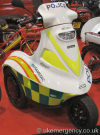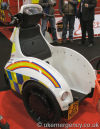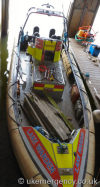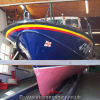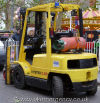Category: OTHERS
This is Rescue Water Craft 15 (RWC-015), part of the RNLI’s beach lifeguard…

This is Rescue Water Craft 15 (RWC-015), part of the RNLI’s beach lifeguard service.
A closer look at the side of the craft.
Here a demonstration shows how the float at the rear is sued to carry people back to shore.
A rear look at the float that is covered in handles to help people pull themselves onto it.
14576 This Land Rover Defender is used by the Civil Defence service on the …

14576 This Land Rover Defender is used by the Civil Defence service on the island of Guernsey. On the roof is an amber light bar, a green rotating beacon and a white searchlight. Green flashing beacons are permitted on Guernsey for all voluntary emergency services when responding to calls, including when travelling to their base for a call out.
SF05 NLU This DAF LF truck is used for bomb disposal work. It is shown …

SF05 NLU This DAF LF truck is used for bomb disposal work. It is shown here in a partially covert mode with no exterior writing visible. Fold-down and magnetic signs reveal its use. The vehicle operates in this partially covert mode so as not to alarm the public and to help avoid it becoming a focus for attack.
The rear view.
This red Massey-Ferguson 240 is used as an emergency doctor vehicle on the …

This red Massey-Ferguson 240 is used as an emergency doctor vehicle on the small Channel Island of Sark. Notice the ‘doctor’ sign on the sun visor and the LED flashing lights on the windscreen.
The rear view. The rear plate reads ‘doctor’ as it is normal to have the owner’s name shown in place of any official registration plate system on the island. The red box is the patient transportation system! It consists of one seat and a storage box. It is lifted off the ground when the tractor is in motion. The cab only has one seat so this bespoke box is essential to transport patients.
Here is the vehicle in use on a misty day showing the red and blue flashing lights.
HG56 LNY This Land Rover Defender is used by the RNLI to drive …

HG56 LNY This Land Rover Defender is used by the RNLI to drive team members to the nearby lifeboat and to tow smaller craft. It is seen here outside the base in Larne. Notice the additions of a front winch (covered), two spotlights and a tow hook on the front.
The rear view of the Land Rover. It has two further spotlights on the rear and carries no high visibility markings.
J25190 This Mitsubishi L200 is used on the beaches of Jersey by the RNLI …

J25190 This Mitsubishi L200 is used on the beaches of Jersey by the RNLI as a lifeguard vehicle.
The car tows this jetski that is used to reach swimmers or surfers in trouble. The yellow float attached to the rear is for rescuees to pull themselves onto for a lift back to land.
The rear view as the car surveys the sea. As the tide ebbs and flows, the car moves to stay near the water’s edge.
In this shot, the same L200 demonstrates its 4×4 capabilities by driving through shallow water to the bemusement of two surfers.
11785, 11784 In this action shot, two motorbikes are escorting a large load…

11785, 11784 In this action shot, two motorbikes are escorting a large load using red flashing lights. They are both Honda Deuvilles belonging to Guernsey Outriders (a division of St Peter Port Service Ltd) who have a contract with the Guernsey government to provide vehicle escort services.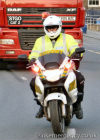
A closer look at one of the escort motorbikes. The company operate three motorbikes and a marked-up van. All use red flashing lights all-round.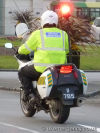
The rear view. The riders are all special constables, trained in the specific role they carry out only. This gives them the power to direct traffic on Guernsey narrow winding roads.
The pair of bikes ready to face another day’s service.
12452 A look at one of Guernsey Outriders’ Honda Deuvilles. Red flashing …
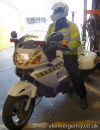
12452 A look at one of Guernsey Outriders’ Honda Deuvilles. Red flashing lights were chosen as the police weren’t keen on blues being used and ambers would not have the desired impact to stop oncoming traffic quickly. A change in law was implemented to make the front-facing red flashing lights legal.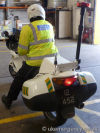
The rear view, showing the high visibility jacket marked with ‘Special Constable’.
R945 TFJ This road-legal monkey bike is decked out in CHIMPS Highway …
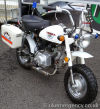
R945 TFJ This road-legal monkey bike is decked out in CHIMPS Highway Patrol livery. The badge on the side says it is ridden by Officer Jim Panzee! It is fitted with blue lights all round and is used as a publicity vehicle. CHIMPS is a play on words of CHiPs, the California Highway Patrol.
The rear view of the quirky bike.
G-CIAS Channel Islands Air Search operate this 1982 Islander aircraft …

G-CIAS Channel Islands Air Search operate this 1982 Islander aircraft for Search and Rescue work (with personalised registration). CIAS is a 24/7 charity that assists in saving lives at sea and is supported entirely by volunteers. The Channel Islands are a distance away from government-funded French and English rescue helicopters and so created their own service in 1980.
The aircraft in its purpose built hanger on Guernsey. It was built in 1982 and came to the service in 1992 with many modifications made. These include extended nose housing for radar, extended wing tips and long range fuel tanks.
Another view of G-CIAS ready for action. With callsign ‘Airsearch One’, it can travel at up to 140 knots and can stay in the air for up to 4 hours 30 minutes. It carries out sea and land searches, including mainland France and England.
The rear view of the aircraft called Lions’ Pride. It can take off with just 100m visibility and the time from call to airborne is about 25 minutes. This includes the time taken for the volunteers to drive to the hanger – a journey that is helped by the use of green flashing lights on their private cars.
The Forward Looking Infa Red (FLIR) pod shown cost £200,000 to purchase and was a massive sum to pay out for a small charitable organisation. However the benefits of having this save lives.
The underside of the aircraft as seen from the sea. The charity use the tag line ‘The Lifeboats’ Eyes in the Sky’.
A close look at the four speakers used as a public address system or siren.
Inside the aircraft. This compact space is for five team members: a pilot, a search director and observers. There is no capability to rescue or transport casualties.
The rear observer seats. The windows are bulged outwards to allow the observers to look straight down. A small chute at the bottom of the photograph allows sea flares to be placed on the sea as markers. Behind the rear seats is an inflatable life raft that can the pushed out of the aircraft to be used by up to 11 people in the sea.
In this staged photograph, G-CIAS is in flight, joined by the Channel Islands’ other rescue services.
WX07 NWB This Mercedes truck is marked in British Transport Police livery…

WX07 NWB This Mercedes truck is marked in British Transport Police livery. It is actually a re-liveried railway response vehicle. This truck carries equipment to Underground stations to fix urgent track problems. The report into the 7/7 Bombings suggested these vehicles were given blue lights to aid their passage in emergencies. This would have required a change in legislation, so this vehicle has been re-designated as a police vehicle and is driven by a police officer.
The same Mercedes Benz Atego truck is its previous livery, prior to February 2012. It is operated by Tubelines to provide an emergency response to incidents on the London Underground and is based at Camden.
YH11 LMU This Land Rover Discovery 4 is used at the Tyne Tunnel …

YH11 LMU This Land Rover Discovery 4 is used at the Tyne Tunnel as a Tunnel Patrol vehicle. It is operated by a company called TT2 who run the four tunnels under the River Tyne in Newcastle-upon-Tyne. In the background is the River Tyne and one of the North Portals into the tunnel.
The rear view. Notice the blue flashing light bar, with the option of red-only to the rear. The Discovery’s livery is designed to compliment the TT2 company logo.
Inside the rear are equipment including fire extinguishers and a skate. In years gone by, the team would be primarily focussed on fire fighting and carried a lot of firefighing equipment. The introduction of a tunnel misting system to put fires out removed the need for this today.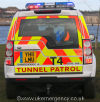
A closer look at the rear of the Discovery.
The South entrance to the tunnel from inside vehicle “Tunnel 4”.
LD08 OMJ This Land Rover Discovery 3 is “Tunnel 1” and is used to …

LD08 OMJ This Land Rover Discovery 3 is “Tunnel 1” and is used to patrol the Tyne Tunnels. On the front are two large black pads. These rubber pads are used to push broken-down vehicles out of the tunnel. The soft rubber avoids any damage. This system is preferred to towing vehicles a few hundred metres to get them out of the tunnel.
A look at the side livery of the Discovery.
The Discovery is parked up, observing vehicles using the North exit. Automated toll booths are used.
A close-up look at the light bar fitted. Eight panels of red LEDs can be seen on the lower layer, with blue lights on top.
FX58 AVY This is a MEV Hummer HX. It is a scaled down version …

FX58 AVY This is a MEV Hummer HX. It is a scaled down version of a Hummer produced by a company called My Electric Vehicle. It is electric only and is comparable to a golf kart. A client commissioned this design and one of their dealers saw it and ordered another for promotional use.
A look at the front, showing the red and blue flashing light bar and white flashing lights in the grille. The car has a retail price in in excess of £10,000.
Another view of this two-seater electric car that is just 3m long. It has a 60 mile range and a 19 mph top speed.
BV60 AOG This 2011 Ford Transit is used as a nuclear response vehicle…

BV60 AOG This 2011 Ford Transit is used as a nuclear response vehicle. It carries the simple livery of a single blue stripe and no writing on the bodywork.
The rear view of this fairly nondescript vehicle.
A look into the rear of the long-wheelbase Transit.
In the middle portion of the van is this office area.
A look at the cab of the Transit. Additional communication equipment can be seen, along with switches for the external lighting.
On the front bumper is a holder for a monitoring device, known as an x-ray probe, which hangs here when deployed and sits just a few inches off the ground.
















